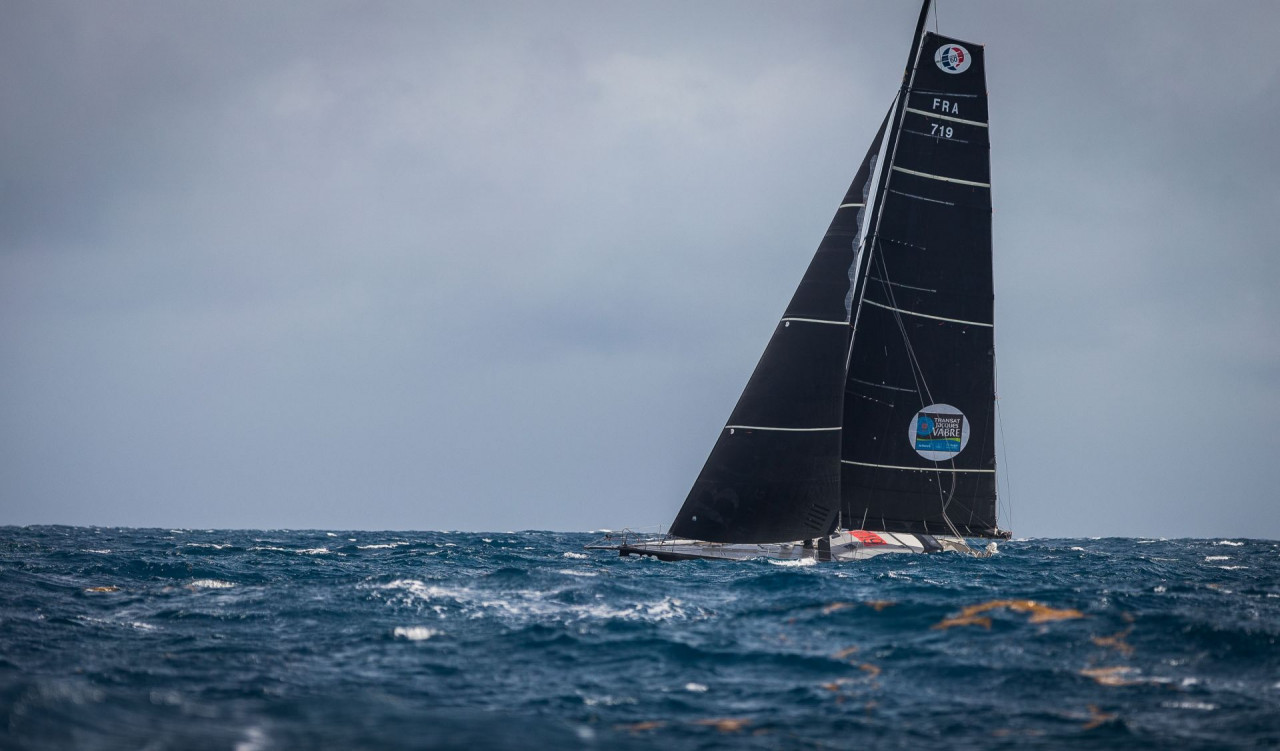Low zones

Last night the Saint Barth – Port La Forêt fleet split. Trying to catch a depression as it formed off the Canadian coast, the three leaders gybed while their three runners-up kept to their route eastwards aiming for another – smaller – depression. Irishman Enda O’Coineen (Currency House Kilcullen) is still close to the wind in a weakening Trade Wind.
“The sky just clouded over, the sea’s got rough, and the wind’s turned 40° to the right – all that in one hour, so very different atmosphere!” said Morgan Lagravière (Safran)half-way through the day on Wednesday. After three days northwards the solo skippers have found what they were looking for: wind from behind, cold, grey…
Change of weather then for this Transat Saint Barth – Port La Forêt, but no change in the ranking. Sebastien Josse (Edmond de Rothschild) still up front ahead of Paul Meilhat (SMA) and Morgan Lagravière (Safran), and Thomas Ruyant (Le Souffle du Nord) leading the second group.
1 Fleet, 2 choices of route, 3 situations
They had the choice of two routes: one slightly longer but considerably windier route to the north with winds of 30 – 35 knots expected tomorrow, rain and a front to deal with; and a second, more direct and further from the zones of depression with windspeeds of less than 20 – 22 knots expected for the next few days.
The first group of three boats took the first option. Sebastien, Paul and Morgan gybed last night to head for an active low pressure system. Thomas Ruyant (Le Souffle du Nord) the furthest north of the southern group, Fabrice Amedeo (Newrest-Matmut) and the Canadian Eric Holden (O Canada) chose the more manageable path.
Irish skipper Enda O’Coineen (Currency House Kilcullen) hasn’t yet had the opportunity to hoist his spinnaker. Close-hauled or reaching he’s still heading eastwards close to the theoretical route, enjoying the gentleness of the tropics.
Twice as much
If the north-runners decide to put the foot down during the conditions expected in their navigational zone, their IMOCA 60s could reach speeds of up to 20-odd knots, especially towards the end of the week as they head to the Azores. On the southern route, the speedometers are unlikely to got above 10 knots. The 200-250 mile sideways gap (60 miles in relation to the race finish) looks likely to grow.
Making it to the End
The gybing – or not – last night was undoubtedly a critical decision that each skipper had to make – or not – according to his soul, his conscience, his priorities and his experience in single-handed racing. The overall objective for everyone is to make it to Port La Foret to qualify for the Vendee Globe, and take full advantage of these 3400 miles alone with their IMOCA60, getting to know her discovering all her intricacies, taming her.
Morgan Lagravière (Safran): “I’m having a great time! It’s full-on, but I’m being reasonable. I’m sailing carefully and double-checking everything.”
“Overall things have been turbulent from the outset, with all kinds of conditions. We’ve just had to negotiate a new buffer zone. At midday the sky clouded over within an hour, the sea got rough and the wind turned 40° to the right. I just pulled on my windbreaker which hasn’t been out of my bag. This is what we were looking for!”
I’m really happy with my race. I’m sailing my own race without heeding much what the others are doing – on purpose. I’m using the tools I have at my disposal, staying conservative because the overall aim is to make it to the end. A mistake is easily made aboard these boats and can have terrible consequences. I’m being prudent, sailing carefully and double-checking everything systematically before every manoeuvre. Last night for example there was 20-25 knots of wind, I had the spinnaker up and things were getting tough, so I decided to take it down.
This first solo IMOCA 60 experience is a great surprise. The race is far from over but I’m having such a good time! Days go by so fast, the rhythm is intense – it’s fascinating!
I’m confident about what comes next because the conditions should stay manageable (30 – 35 knots forecast) and we can handle that. When the wind’s strong we have small flat sails which are easier to handle than the big hollow sails. And on top of that we’re at last heading for a route that will take us closer to our goal!”
Teams info
Pip Hare's perspective on The Transat CIC
IMOCA skippers who are not participating in The Transat CIC are like us, glued to the map and race updates to analyze and understand the performances of their peers in the class.
•••IMOCA Race Report #2 I The Transat CIC - Day 6
At the halfway point, Conrad Colman, skipper of the IMOCA MS Amlin, gives us an update on what's happening at sea. Strategy, weather forecasts, conditions on board... you'll know it all!
•••